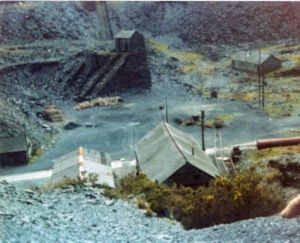Aberllefenni Slate Quarry
Aberllefenni Slate Quarry is the collective name of three slate quarries, Foel Grochan (sometimes misspelt as Foel Crochan), Hen Chwarel and Ceunant Ddu, located in Aberllefenni, north Wales. It was the longest continually operated slate mine in the world until its closure in 2003. Foel Grochan is the quarry on the eastern side of the valley, facing Ceunant Ddu and Hen Gloddfa on the west; all three were worked as a single concern throughout their history. Technically all three of these are mines, not quarries, since all rock extraction takes place underground, though they are often referred to as quarries.
History
Aberllefenni Slate Quarry may have started operating as a slate mine as early as the 14th. century. The earliest confirmed date of operating is 1500 when the local house Plas Aberllefenni was roofed in slates from the mine. Sadly, by the end of the 20th century it was no longer financially viable to extract slate from the site, leading to its closure. The mining company, Wincilate still continues to operate in Aberllefenni, cutting and preparing slate imported from China.
Operations
One of the reasons for Aberllefenni Slate Quarry's continued use was the high quality of the slate extracted. There are two major "bands" of slate running parallel to each other through this region of mid-Wales, the "broad vein" and the "narrow vein", the latter of which Aberllefenni extracted. The broad vein is of considerably poorer quality than the narrow vein, and the slate it produces is of little use in roofing slates or polished surfaces. Instead it was used in walls, fences and hardcore. The narrow vein was of much better quality and could be used in much higher quality applications and fetched higher prices.
Slate extracted from the narrow vein at Aberllefenni is deep blue and extremely hard and dense. It resists fine splitting, so most of the mines' product was large cut slabs rather than split roofing slates. Foel Grochan mine consists of eight near-horizontal tunnels at approximately 60 feet vertical separation. These were bored into the valley side just to the north of the near-vertical narrow vein. Each tunnel connected to a large chamber from which the rock was extracted. These chambers ranged from 100 feet to 187 feet in length with 24 to 30 feet of rock left between the bottom of one chamber and the top of the next lower chamber. As more slate was extracted, several of the upper chambers were joined vertically to form an extremely large cavern known as Twll Golau which is open at the top.
Transportation
From the mid 1850s the quarries at Aberllefenni were connected to the Corris Railway, a narrow gauge railway which carried slate down the Dulas Valley to Machynlleth. There it was transferred to the standard gauge Cambrian Railways and shipped throughout Great Britain. In the 20th Century the railway's use was discontinued, instead the slate carriages were pulled by a tractor. The railway has now been removed.
References
Richards, Alun John (1994). Slate Quarrying at Corris. Gwasg Carreg Gwalch. ISBN 0-86381-279-1.

